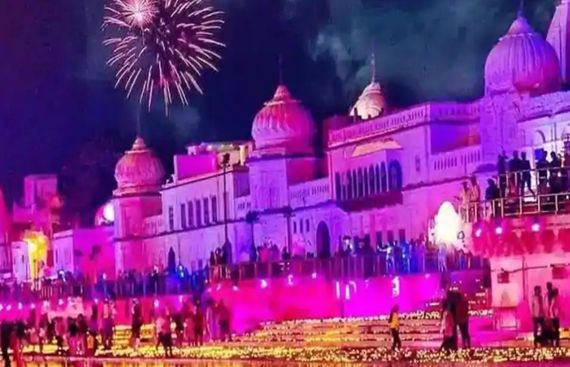Ayodhya's First Diwali After 500 years: A Record 5.51 Lakh Diyas to be Lit

As the nation is gearing up to celebrate a gloomy Diwali this year, Ram Janmabhoobi, Ayodhya is all lit up to celebrate its first Diwali – Ayodhya Deepotsav 2020 after about half a century. Mythology stories reveal that about 5,000 years ago, Lord Ram’s homecoming after completing his 14-years long exile was welcomed by the people of Ayodhya lighting diyas. This evolved as a tradition with each passing year and today Diwali is celebrated as one of the universal festivals irrespective of language, religion, caste, and creed.
About 500 years ago, history claims that the Ram Mandir was replaced with Babri Masjid, and the residents of Ayodhya have been waiting for the return of Lord Ram to his dwelling. However, the Supreme Courts’ verdict has finally closed the prolonged controversial case of Babri Masjid. After obtaining the judgment in November 2019, the construction of much anticipated Ram Mandir began in August 2020, after our honorable PM Narendra Modi performed the Bhoomi Pujan.
As Ayodhya is celebrating its first Diwali, Uttar Pradesh Chief Minister Yogi Adityanath is personally supervising the preparation of Deepotsav. Also, the Ram ki Paidi would be lit up with 5.51 lakh diyas, however, the government is hoping to break its record of lighting 4, 26, 000 diyas last year, across Ayodhya. Around 10,000 volunteers are working day and night to complete the Deepotsav 2020’s preparation.
Although the preparation for Deepotsav is in full swing, the COVID-19 restriction has limited the celebration of Ayodhya’s first Diwali. Hence, considering the COVID-19 restriction, the Uttar Pradesh government has developed a web portal to facilitate the Ram devotees to virtually take part in the celebration and to light the lamps on this Diwali in Ayodhya. In this web portal, the devotee would be able to select from a varied choice of lamps such as earthen, copper, brass as well as gives the choice for oil to light it. If at all the pandemic has not occurred, Ayodhya would have witnessed millions of devotees would have been part of the Deepotsav, which is celebrated after 500 years.
Neelkanth Tiwari, State Tourism Minister says “More than 5 lakh lamps will be lit on the occasion of Diwali. If there was no coronavirus pandemic, lakhs of devotees would have participated in this program.”
This Diwali the government also chooses to go organic, thus, its gaushalas are producing special lamps made out of cow dung. These lamps would also be used to light up in the Ram Mandir campus. About 33 crore cow dung lamps have been produced out of which nearly three lakh lamps would be used in Ayodhya. This initiative has been started by government enterprise Rashtriya Kamdenu Aayog.
As a part of the celebration, all the monasteries and houses would be lit up in and around Ayodhya on this Diwali. The singing of bhajans and Ramayana recitals would also be held in monasteries in addition to the grand eye-catchy decoration of Ayodhya on the eve of this festival of lights.
Mahant Nritya Gopal Das, Chief of Shri Ram Janmbhoomi Teerth Kshetra Trust says “It will be a real Diwali this year, which will celebrate the return of Lord Ram after a prolonged exile.”
However, the construction of Ram Mandir is expected to boost tourism across Ayodhya as well as Nepal’s Janakpur – Sita’s birthplace, which is also a part of Ramayana. This place is the pilgrimage as well would attract the devotees coming to Ayodhya. This in turn is foreseen to boost the economy of the region by bringing in employment opportunities to the people residing in and around these regions.
